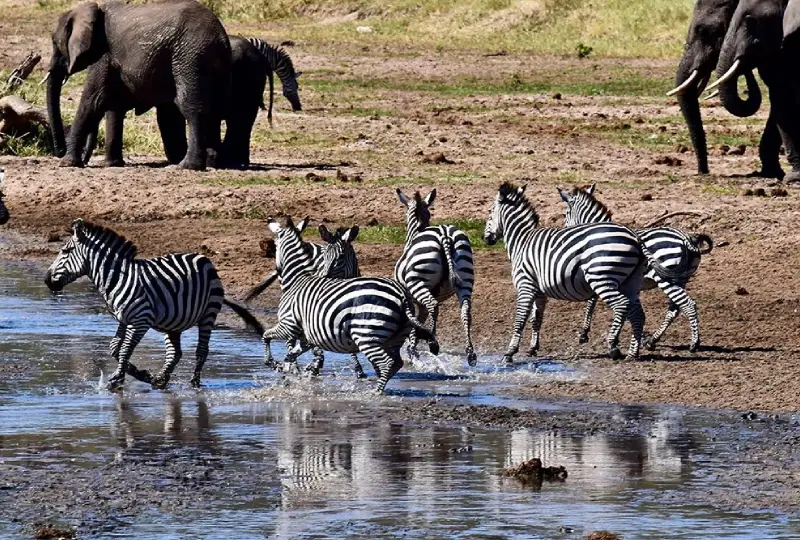Tarangire National Park Overview
Tarangire National Park is one of Tanzania’s most enchanting safari destinations, renowned for its sweeping landscapes dotted with ancient baobab trees and its abundant wildlife. Located about 120 kilometers southwest of Arusha, the park covers more than 2,800 square kilometers and forms part of Tanzania’s famous Northern Safari Circuit. Its lifeline is the Tarangire River, which draws animals in huge numbers during the long dry season, creating some of the most dramatic wildlife spectacles in East Africa.
The park is especially celebrated for its enormous elephant herds, often seen in groups of several hundred, making Tarangire one of the best places in the world for elephant viewing. Alongside elephants, the park is home to thriving populations of lions, leopards, cheetahs, hyenas, buffalo, giraffes, wildebeest, and zebras. Rare antelope species such as fringe-eared oryx and greater kudu also roam here, while the tiny dik-dik darts through the bush. Birdlife is equally remarkable, with over 500 recorded species, including the striking Kori bustard, dazzling yellow-collared lovebirds, and massive flocks of hornbills.
What sets Tarangire apart is its sense of wilderness and tranquility. Unlike the Serengeti or Ngorongoro, it is less crowded, allowing for a more intimate and peaceful safari experience. Visitors can enjoy classic game drives, birdwatching, guided walking safaris, and cultural interactions with nearby Maasai communities. With its combination of iconic scenery, diverse wildlife, and serene atmosphere, Tarangire offers a safari experience that is both thrilling and deeply memorable.
What makes Tarangire National Park unique?
Tarangire is unlike any other park in Tanzania. Its most striking feature is the landscape, where towering baobab trees, some centuries old, dominate the savannah and create a dramatic backdrop for wildlife photography. The park’s defining feature, however, is the Tarangire River, which sustains life throughout the dry season. As other areas dry up, thousands of animals migrate to Tarangire, resulting in one of the highest concentrations of wildlife outside the Serengeti. This seasonal congregation of elephants, wildebeest, zebras, and predators makes the park a hidden gem for safari enthusiasts seeking spectacular game viewing with fewer crowds.
What animals can you see in Tarangire National Park?
Tarangire is a paradise for wildlife lovers. The park is famous for its massive elephant herds, but it is also home to a wide range of other animals. Lions, leopards, and cheetahs are regularly spotted, while spotted hyenas roam the plains. Large herds of wildebeest, zebras, buffalo, and giraffes graze across the savannah, and smaller species such as impala, waterbuck, and bushbuck are commonly seen. Rare animals like the fringe-eared oryx and greater kudu add to the park’s diversity. For birdwatchers, Tarangire is exceptional, with over 500 bird species ranging from colorful lovebirds to raptors like bateleur eagles, making it one of the best birding destinations in Tanzania.
How many days should I spend in Tarangire National Park?
While a single day trip to Tarangire can provide a rewarding glimpse of its landscapes and wildlife, spending two to three days is highly recommended. With more time, you can experience game drives at different times of day such as sunrise safaris when predators are most active or evening drives that reveal the park’s golden beauty. Multi-day stays also increase the chances of spotting elusive animals like leopards and rare antelopes. Some lodges and camps even offer guided walking safaris and night drives (in select concession areas), allowing visitors to experience the park from unique perspectives.
What is the best time to visit Tarangire National Park?
The dry season (June to October) is the best time to visit Tarangire. During these months, the Tarangire River becomes the park’s only permanent water source, attracting massive gatherings of elephants, wildebeest, zebras, buffalo, and predators. This creates some of the most spectacular game viewing opportunities in East Africa. However, the wet season (November to May) also has its appeal. The landscape transforms into lush greenery, birdwatching is at its peak with migratory species, and the park is quieter with fewer tourists. For travelers seeking solitude, photography opportunities, and vibrant scenery, the wet season is equally rewarding.
Is Tarangire National Park suitable for family safaris?
Yes, Tarangire is an excellent destination for families. Its relatively smaller size compared to the Serengeti means shorter game drives, which are easier for young children. The park’s abundance of elephants is particularly captivating for families, as children are often amazed by watching these gentle giants interact. Many lodges and tented camps near the park are family-friendly, offering spacious rooms, swimming pools, and activities tailored for younger travelers. The combination of thrilling wildlife, scenic beauty, and accessible safari routes makes Tarangire an ideal family safari destination.
Can Tarangire be combined with other parks?
Absolutely. Tarangire is part of Tanzania’s Northern Safari Circuit, making it easy to combine with nearby parks such as Lake Manyara, Ngorongoro Crater, and Serengeti National Park. Many safari itineraries begin with Tarangire due to its close proximity to Arusha before continuing to the Serengeti or Ngorongoro for extended wildlife adventures. This combination provides travelers with an incredibly diverse safari experience, ranging from Tarangire’s iconic elephants and baobabs to the dramatic predator action of the Serengeti and the unique volcanic landscapes of Ngorongoro.

